Snipes galore.
Two days ago as I was driving by, I saw a small group of Wilson’s Snipes land in the tall grass near some water so I turned around to see if I could get them in my viewfinder. As I slowly inched forward I knew where they were but I couldn’t see them, until they started flying off in groups of two or three.
I hate flushing birds so I just stopped and waited, hoping that any snipes that were left would eventually show themselves.
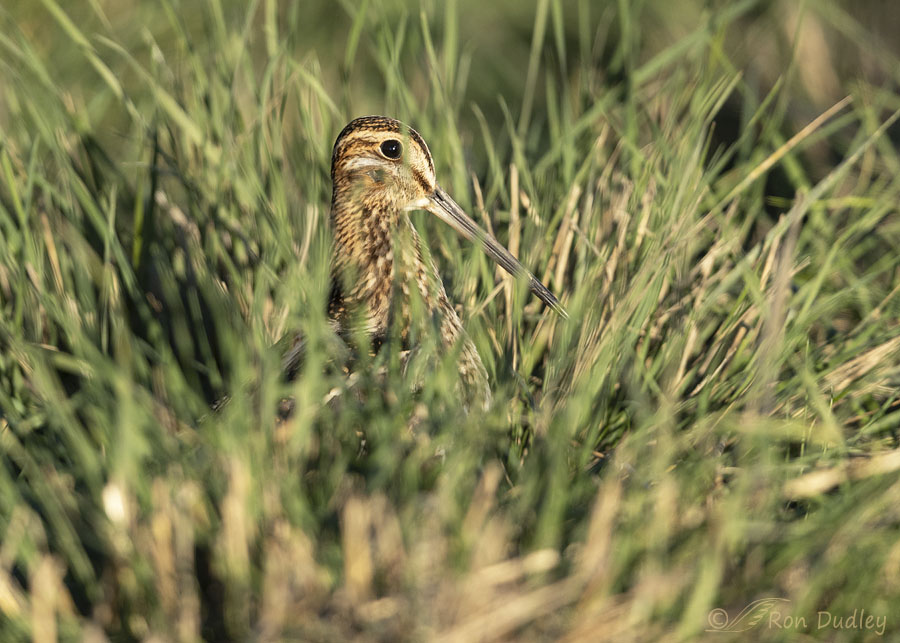
It took at least five minutes but finally, a single snipe popped its head up out of the grass.
Eventually, others started coming out into the open. This guy, one of the first, kept a pretty close eye on me for a while but soon they all went about their business as if I wasn’t there.
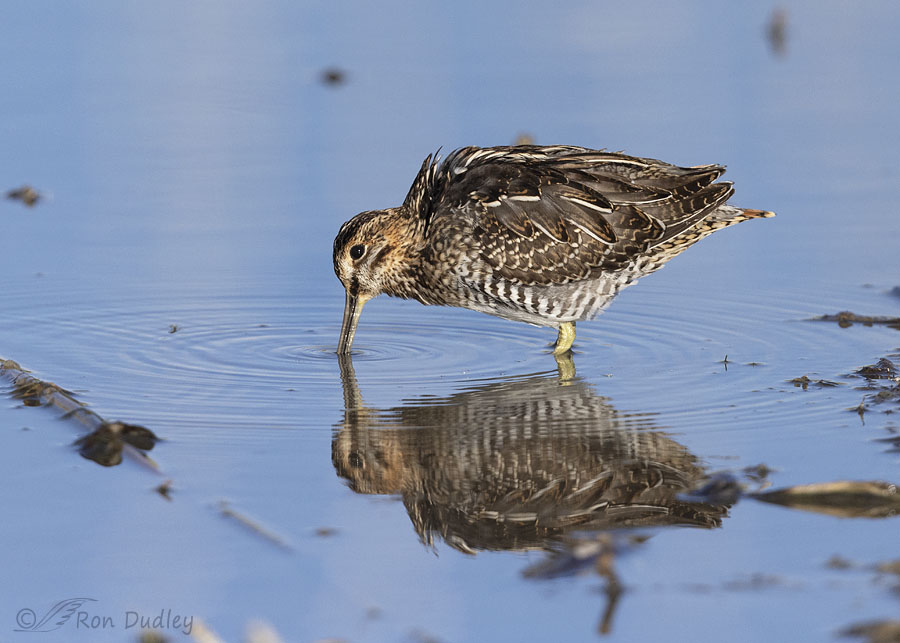
Snipes use their long bills to probe in mud, on land or in shallow water, for their food. Typically they eat larval insects, crustaceans, earthworms and mollusks but as much as 66% of the material found in their stomachs is plant material.
Inexplicably, Cornell’s Birds of the World says that they probably get “little or no energy” from the plants they eat. Doesn’t quite make sense to me…
This time this bird came up empty, or it ate something tiny before its bill came out of the water.
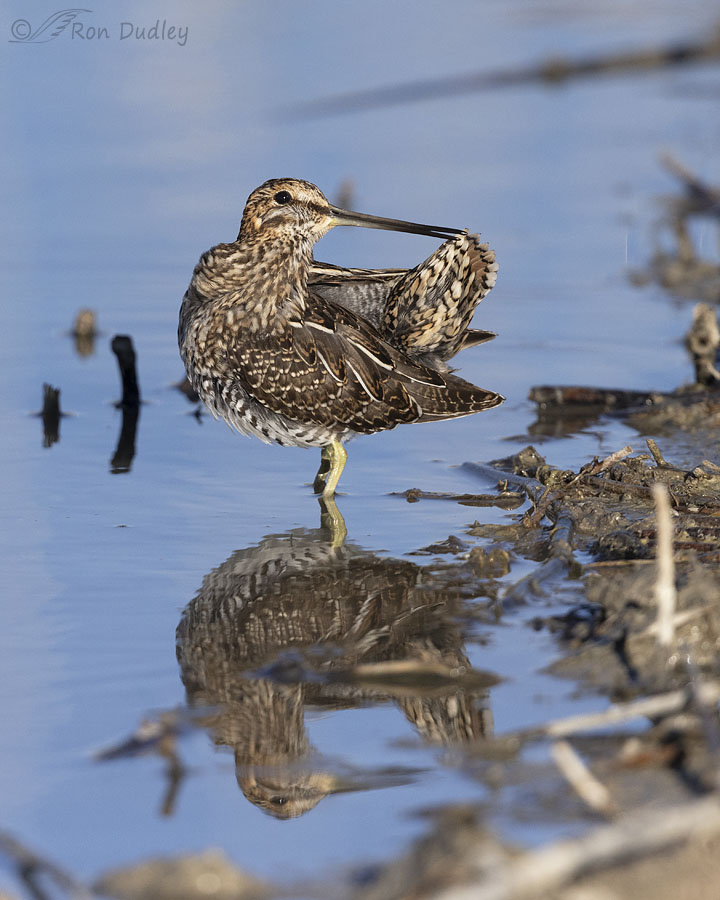
By now, dozens of snipes had come out of the grass and started doing all the things that snipes do, including preening. Here we see a little rhynchokinesis at the tip of its bill.
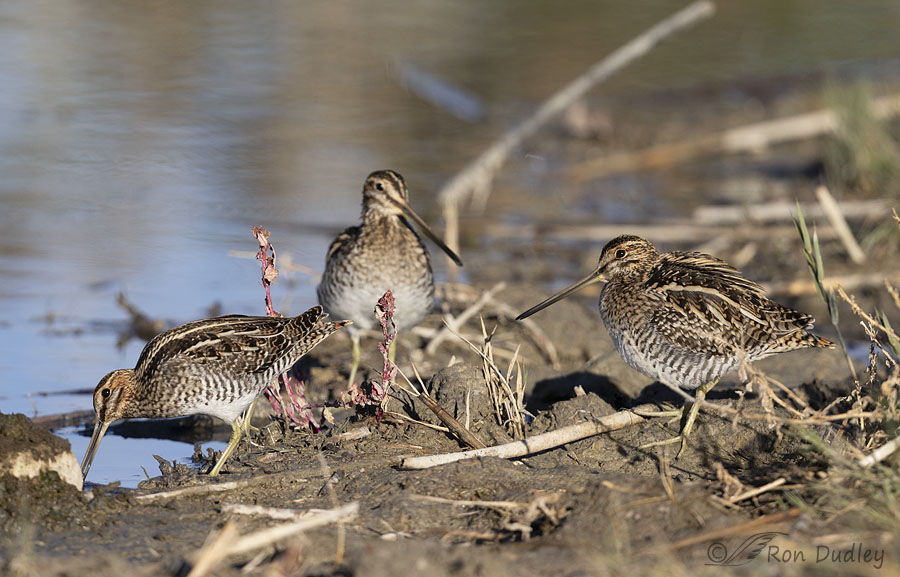
At first I was pretty excited to get more than one snipe in the frame at the same time, even though I didn’t have enough depth of field to get them all sharp. In my experience with snipes in the past, they’re usually fairly solitary birds or they’re found in very small groups so it had been out of the ordinary for me to get several of them in the same frame.
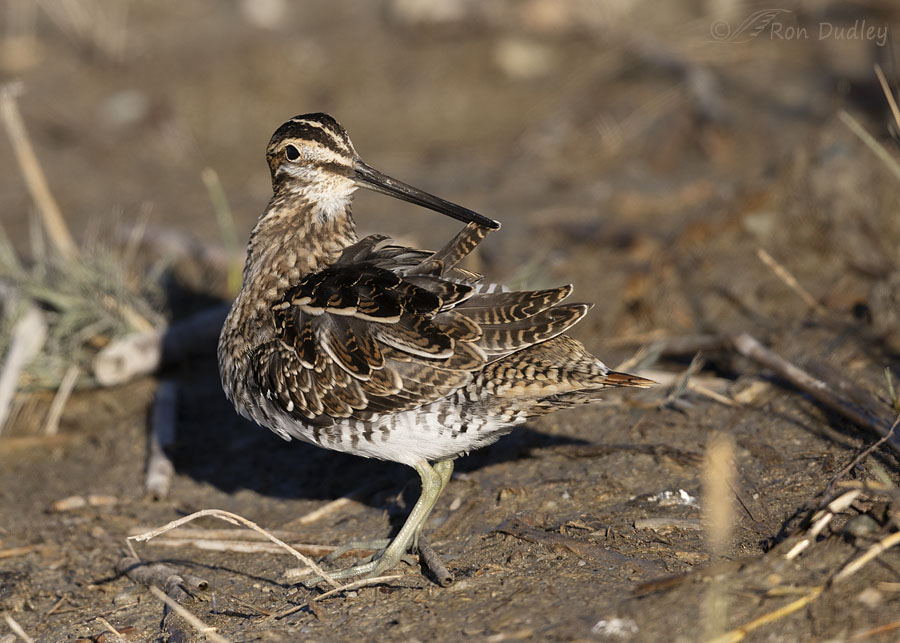
This one preened right in front of me for a long time so I got lots of photos. This is one of my favorites, even though there isn’t a catch light in its eye.
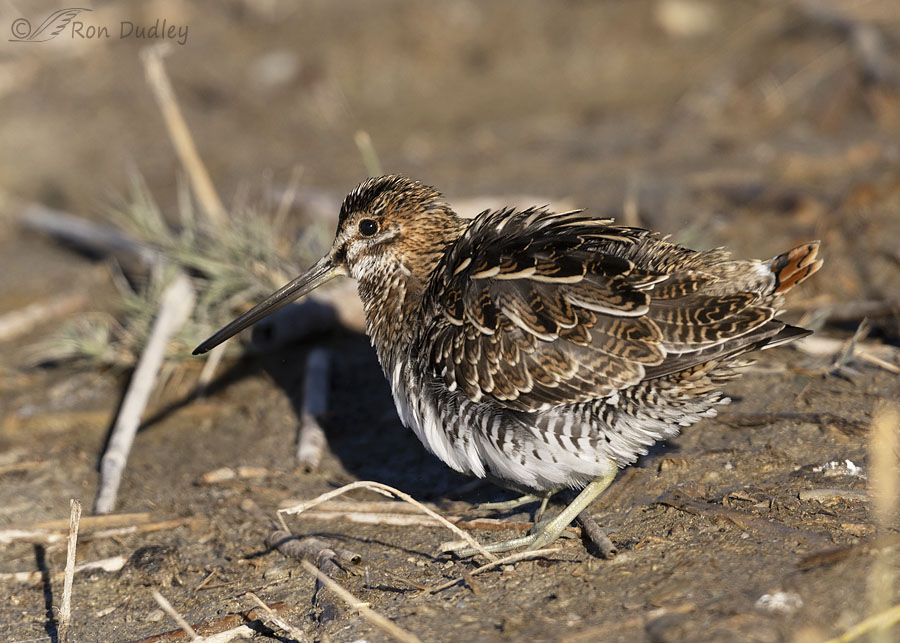
When the same bird roused at the end of its preening session, its individual feathers were exceptionally well defined.
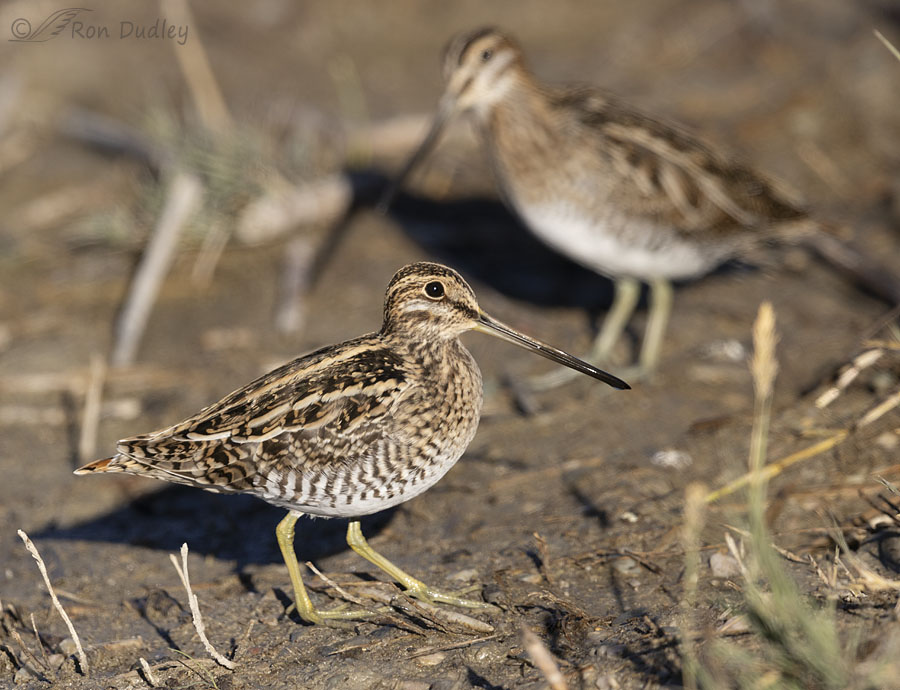
By now I’d been with the snipes for 39 minutes and during that time small groups of them had been flying off and replaced by other groups that flew in and landed amongst the others. But far more birds were flying in than flying off so the entire area was becoming thick with snipes.
As a result, it was becoming more and more difficult for me to get photos of individual snipes that weren’t photobombed by other snipes.
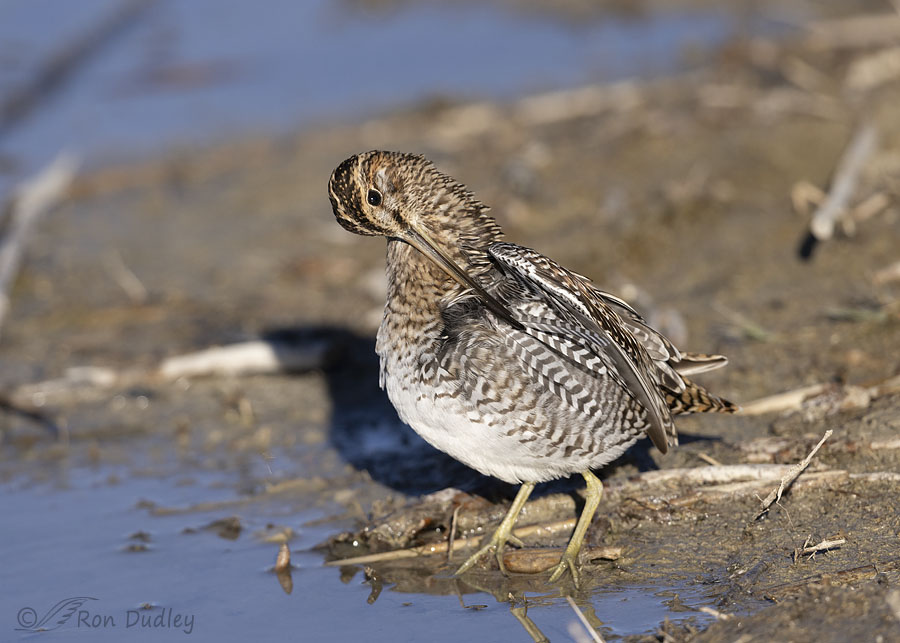
Another snipe that insisted on showing me ‘his’ preening technique up close. He worked on that one isolated feather, the one he’s grasping with the tip of his bill, for a long time.
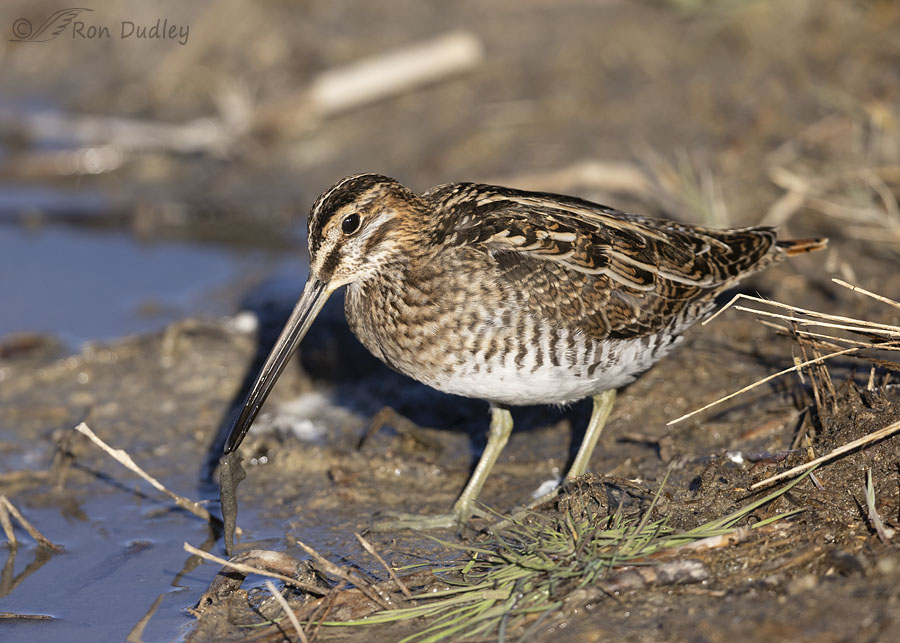
This was the only time I could see what a snipe was eating.
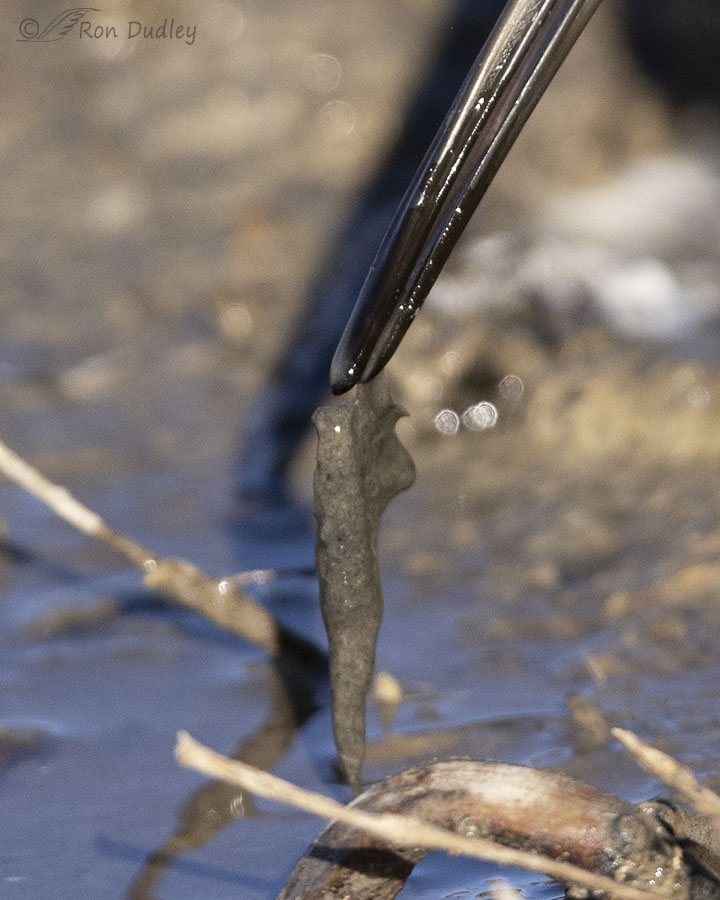
To me it looks like it might be a mollusk (slug?). At first I thought it might be an annelid (leech?) but I can’t make out any segments, although leech segments can be hard to see. All I can tell for sure is that it’s an invertebrate. Any thoughts?
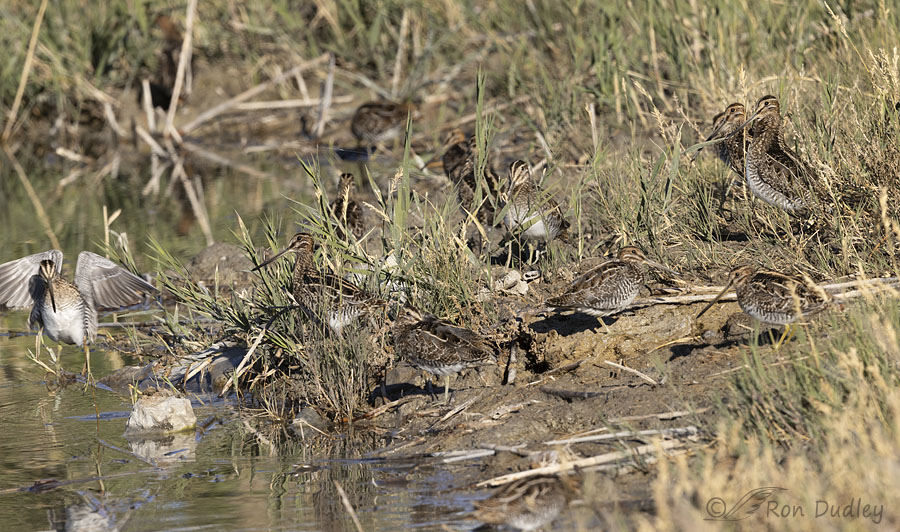
This is what the entire 75′ section of shoreline was beginning to look like. It was crawling with snipes, including an unknown number of them hidden in the taller grasses a little further away from the water. More birds continued to fly in and land than flew away.
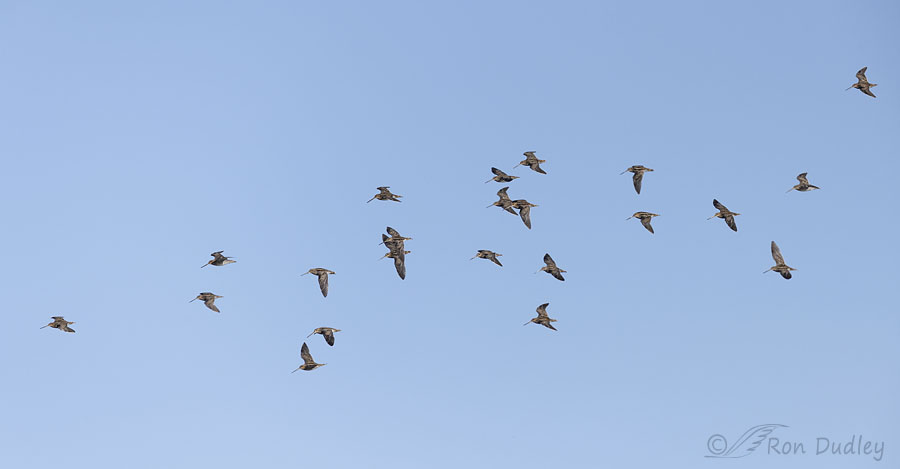
And they came in in flocks ranging from about a half dozen birds to roughly 50 of them. Here we see 22 snipes in flight but there were quite a few more out of frame.
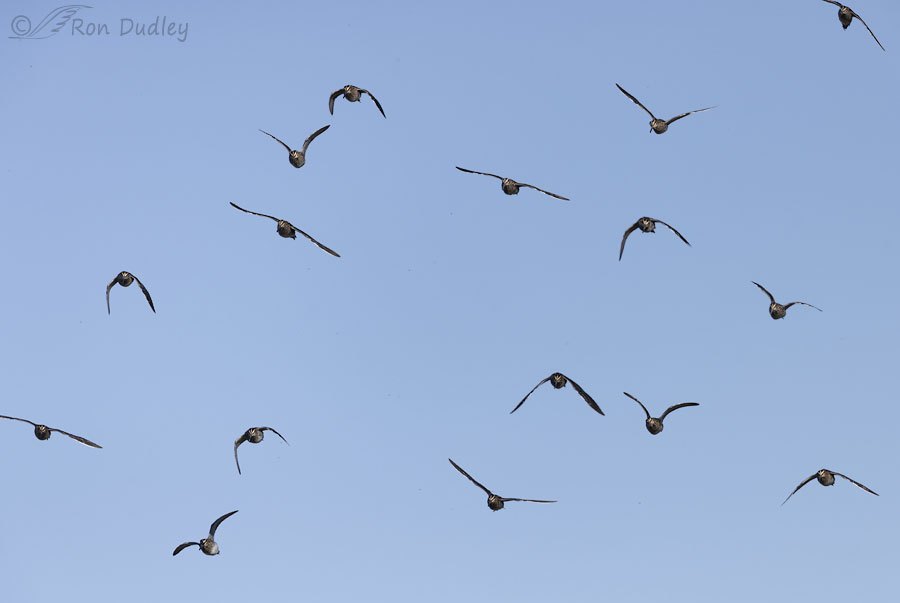
Typically the flocks would fly right over my head, presumably to make sure it would be safe to land, and then they’d circle around and join the other snipes on the ground. Occasionally, a flock would decide against landing and fly away. To where, I don’t know.
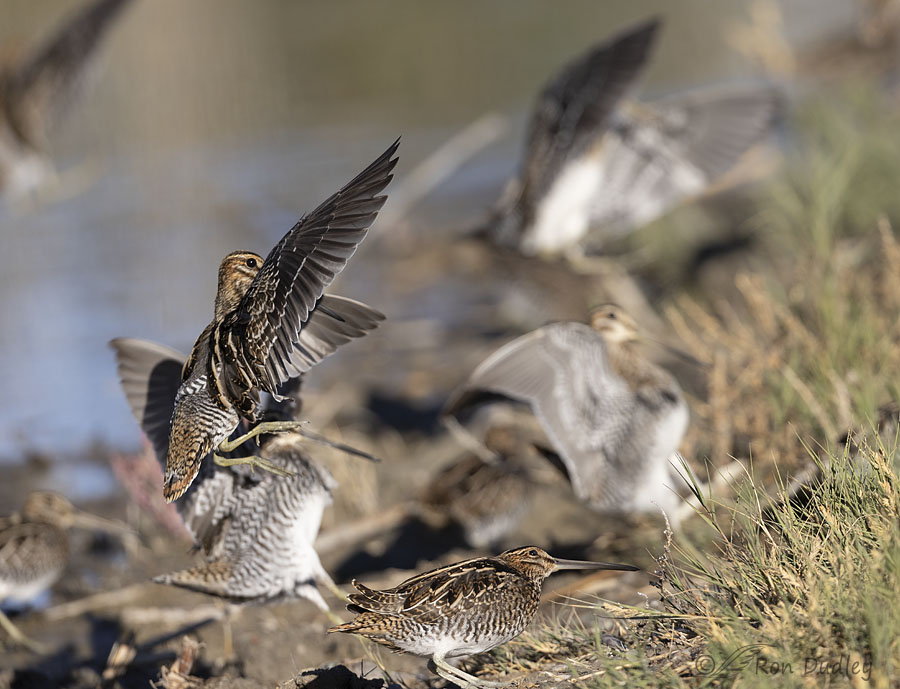
I tried repeatedly to get landing shots but the conditions for getting good ones were very difficult.
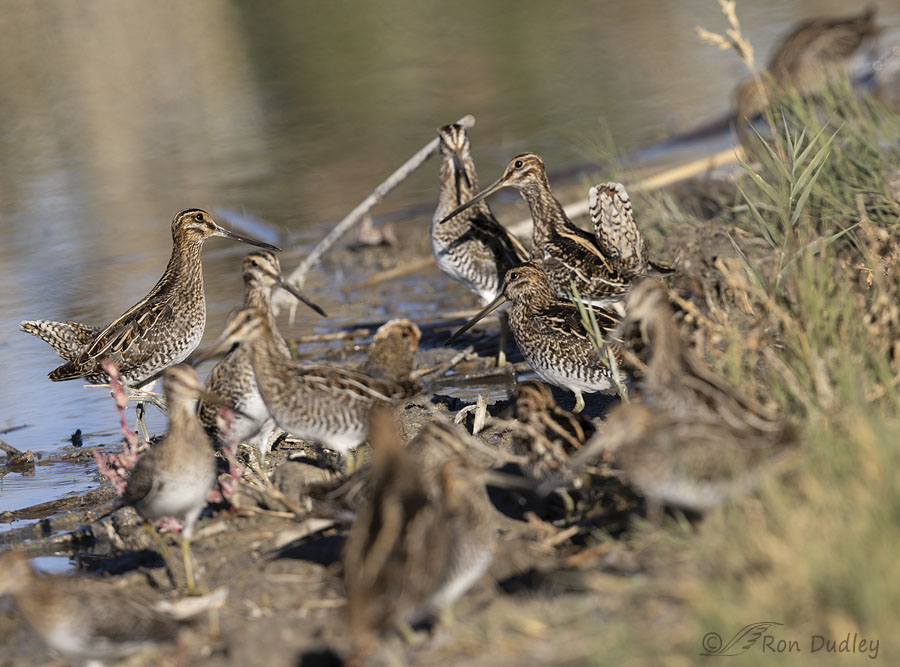
When a group of snipes would land, they repeatedly formed nearly circular groups of birds facing each other. They interacted with each other in ways I don’t understand. I never saw them fight and I couldn’t hear them calling to each other (although they may have been, softly) but their body language made it obvious that they were interacting with each other in ways that were mysterious to me.
Whenever they formed these nearly circular groups I thought of them as “conventions” of snipes. The only thing missing was name tags.
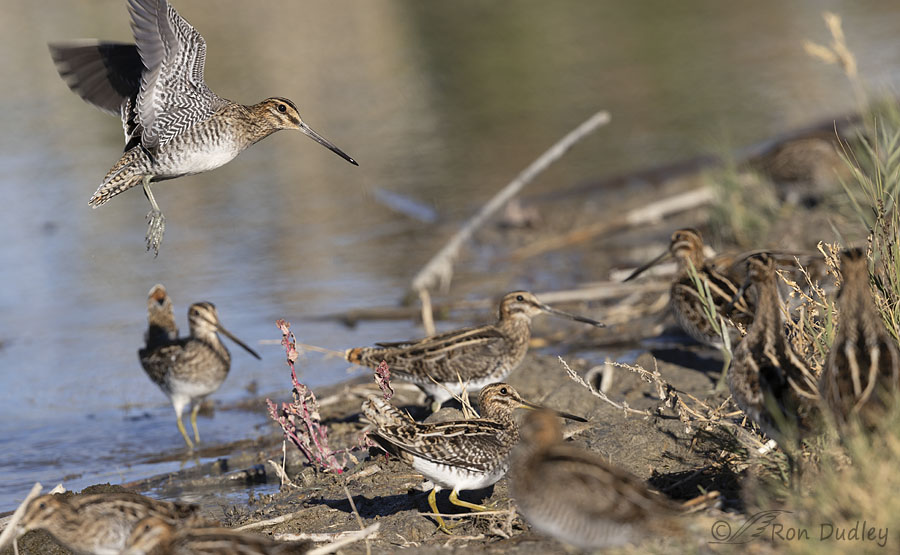
Another snipe flying in to join the “convention”.
I could continue but this post is getting too long.
I spent over an hour with these birds and I had them all to myself for the entire time. I probably spent too much time trying to count, or estimate, how many snipes were surrounding me in three dimensions. It was tricky because there were the snipes I could see near the shore, snipes hidden in the grass and often others in flight overhead. But eventually I arrived at a conservative estimate of at least 200 snipes. There may have been significantly more.
As you can imagine, I had the time of my life.
Ron
Notes:
- I believe the 18 photos I posted today is a new record for Feathered Photography. That’s my excuse for not having the time to include image techs. Sorry.
- Among several strange behaviors I documented with these snipes, one of them stood out as being weird, even a little bizarre. I photographed that behavior several times and I plan on posting some of those photos tomorrow. After some research I think I now understand its purpose. Then, I promise, no more snipe photos for a good long while.


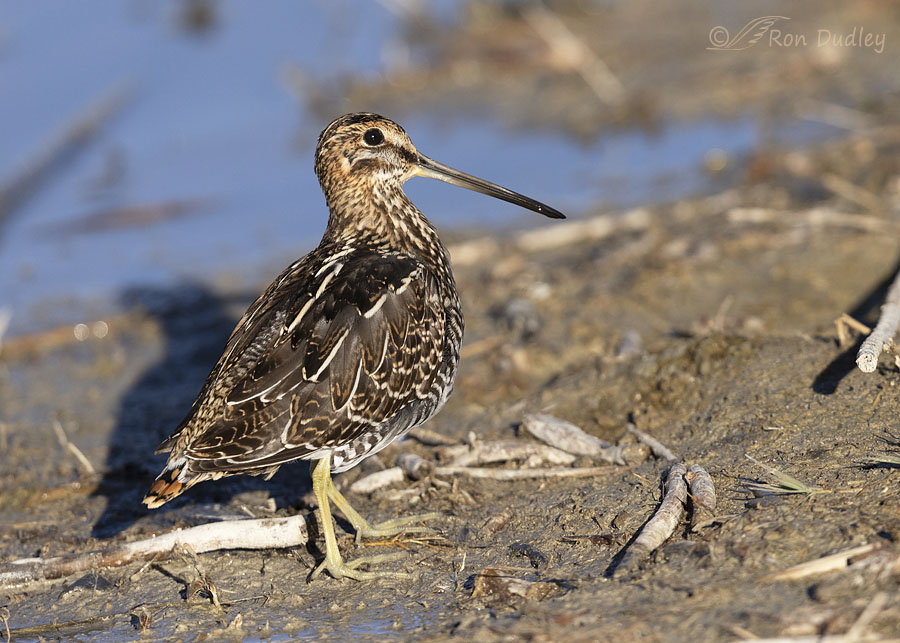
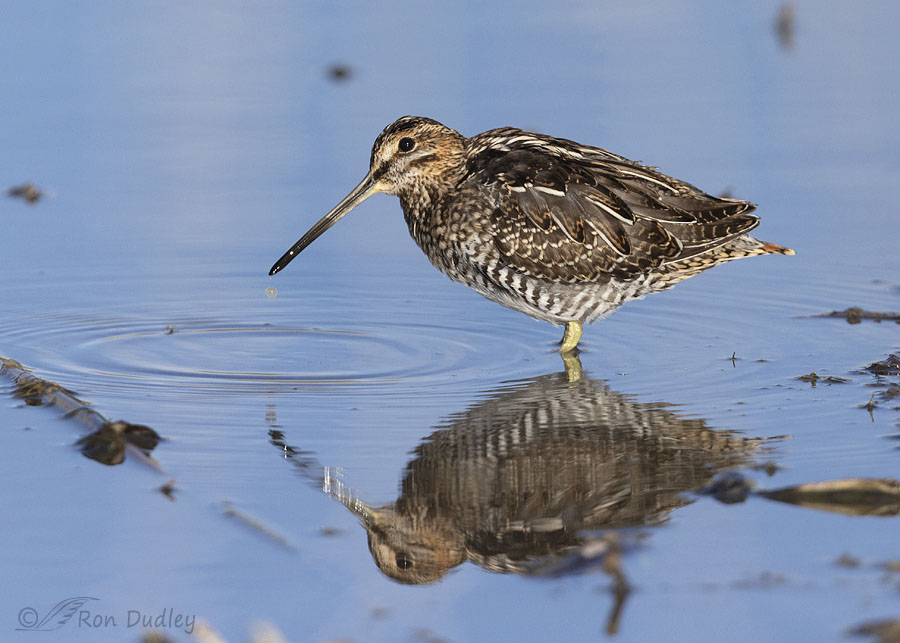
I never would have guessed you have 18 images in this post–it is so compelling I don’t want to stop. Glad you were able to have a great day in the field as you deserve it.
Thank you, Linda. When you have to process this many photos, you’re hyper-aware of how many there are.
Very neat photos! They were still there this morning but so where the hunters this morning, 4 boats. When I arrived there were three trucks with empty trailers two more arrive and launched and one of the first three returned and pulled out. The shooting was right in the channel. The snipes were mostly on the other side but a few sleeping in the grass almost invisible. There were a lot! I’d say more than 200. They would flush from a large area when shots were fired close by, or a boat revved, both a heron and harrier flew over and huge flocks flew in a circle around the area and returned to almost the same location. I couldn’t get as close as you they were farther down the bank in and behind the tuft of grasses shown in your 13th photo in this series. I did not get many flight shots, I was at a bad angle for the directions they were coming and going. They are vocal, both the startle, warning call as they fly and they make soft noises almost like our coturnix quail as they feed, huddle and walk together. I have, I hope, some nice shots. I am just going to download them now.
I’m glad you spent some time with them, April. And to know the numbers you saw seemed reasonably close to my estimate of 200+. It seems that they were more vocal for you than they were with me, or maybe I just wasn’t hearing them. Like a lot of men, I can’t hear high-pitched calls from birds like Cedar Waxwings. I hope you got some shots you like.
Pretty cool snipe party! All they need is to be holding cocktails — and there’s always someone hangin’ by the buffet!
Thanks, Marty.
A snipe cocktail party is not to be missed, I hear! Just ask Ron!
I can well understand your excitement. Who knew that a mostly from what I gather solitary bird would choose to do a jamboree where you could see and photograph it.
Looking forward to your next post about them too.
Jamboree – I may like that even better than convention. Thanks, EC.
This is a fabulous series of photos! More, please! Regarding the food item: I am certain it is a polychaete annelid, possibly in the family Ampharetidae. (Polychaetes have been one of the subjects of my studies over the past 45+ years). Several species of polychaetes build mucous-lined tubes with various bits of plant material attached (other species, like ‘ice cream cone worms’ use sand grains). It looks like the snipe has pulled the entire tube out of the mud – I wonder if it swallows the entire thing – maybe that is how at least some of the plant material gets into the gut).
Nancy, I’m somewhat familiar with polychaetes but I never considered the possibility because I don’t see any parapods on this critter and I thought (assumed) polychaetes are all marine.
But you obviously know much more about polychaetes than I do and your mention of a mucus tube explains why I’m not seeing any parapods. Many thanks for apparently pointing me in the right direction!
Fresh-water polychaetes are rare, but check out Manayunkia speciosa (for example). Wish I could have that specimen in hand (ha!)
Next time I see a snipe with a polychaete I’ll ask ‘him’ to toss it my way!
Great to see so many snipes and in the open.
Sorry for coming in late today (eye problem). Now that I can see again I have a suggestion about the high amount of plant material. Like many birds, snipe cast pellets. The grit, plant fibers and small seeds all help with the formation of pellets in the gizzard. It is easier for the muscles of the stomach to form a tight pellet if these materials are present.
Dan, I wondered about the explanation you provided – grebes eating feathers for a somewhat similar reason made me think of it. But up to “66% of their stomach contents being plant material” seemed high to me for that purpose. But what do I know…
I really, really hope your new eye problem has been resolved permanently.
Thanks. The surgery on the one eye was very successful and should minimize future problems. That’s the hope since the other eye has been nearly useless since the damage from leukemia.The best news is that the leukemia specialist, who once said he has a hard time using the words cure and leukemia in the same sentence, has just told me I’m cured.
Cured!!! And from leukemia no less. That’s simply wonderful.
You fought the good fight and beat the bastard. I couldn’t be happier for you. And for Barbara.
WONDERFUL news. Happy dances from Australia.
“Convention of snipes” is a great phrase I’m not sure I’ve ever seen more than one or maybe two snipes at a time, so these shots are pretty amazing to me. I know for sure that the sound of their winnowing flight in an evening sky is one of my favorite sounds of nature, so I love having snipes around.
I’m not sure I’ve ever seen more than one or maybe two snipes at a time, so these shots are pretty amazing to me. I know for sure that the sound of their winnowing flight in an evening sky is one of my favorite sounds of nature, so I love having snipes around.
Bill, in tomorrow’s post I plan to tell folks a little about the sound of their flight that I learned that morning. Up close and personal, it was quite a revelation for me.
Sensational series, thanks for sharing!
Charlotte Norton
Thanks, Charlotte.
Our winter snipe seem to be solitary or maybe in pairs on the coast. Inland, they make small flocks at the wildlife sanctuaries. For brown and black birds, they blend into green grass remarkably well. I was getting ready to start my Christmas Bird Count and had a small group going with me. While everyone was settling their gear and chitchatting, I looked down to see a snipe frozen behind someone’s heels. Of course, once I called attention to it, everyone moved and off went the snipe.
Glad they didn’t step on it, Marcia.
It’s hard not to anthropomorphize that first “perky“ bird, popping up out of the grass.
Brian Wildsmith calls them a “walk of snipe.“ But I like convention better. I’ve never seen more than one snipe at a time so I am thoroughly envious of all this, and there’s no need to stop sharing these photos with us, Ron.
Thanks. The habitat must be perfect for them.
They do seem to like that habitat, Ellen. I’ve seen them there before.
Ron, your patience is amazing, and it really paid off for us all! How long did the birds continue relating to each other in those circles? Did the many birds landing together form one large circle or a series of smaller ones?
Marcia, I’d estimate for a bout 30 seconds, usually. Usually one circle at a time.
What is a convention of snipes called, do you think? With those long beaks, it should be something indicating that.
Simply calling it a “convention” works for me. At least until I hear something better, or more descriptive.
What beautiful birds they are ! And it’s encouraging to see large numbers of any kind of birds together…..the masses of verbiage
Snipes eat makes me think of how domestic cats eat a lot of grass,
just to “keep things moving along”. The circle of Snipes that you
captured having some kind of communication is mysterious and
intriguing– it does indeed look like a “conference”……..
” it’s encouraging to see large numbers of any kind of birds together”
Kris, I keep having the same thought. Especially these days with so many species in drastic decline.
“I had the time of my life”.
Just when you feel things have took a bad turn, nature comes through with a bonus day. Snipeapalooza!
Great photos! Have no idea what that food item is.
Looking forward to the next post.
FYI – Saw our first Junco of the season in the backyard yesterday, and seemingly in spite of the 100 degree temps.
Michael, I appreciate the irony of the timing – a “snipe bonanza” almost immediately after I announce to my readers that I’ll be taking some time off from blogging because I can’t find enough birds to photograph.
I saw and photographed my first junco of the year a few days ago at Farmington Bay WMA. Still haven’t seen any in my yard.
WOW!, just WOW!…….VBG Birds always find a way to “deny” our assumptions regarding their behavior it seems….. The feather detail is beautiful and close up I wouldn’t think of it’s camoflage value but there it is!
The feather detail is beautiful and close up I wouldn’t think of it’s camoflage value but there it is!
Glad you enjoyed them, Judy. Thank you.